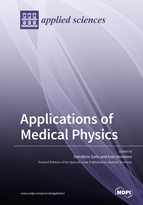Applications of Medical Physics
A special issue of Applied Sciences (ISSN 2076-3417). This special issue belongs to the section "Applied Physics General".
Deadline for manuscript submissions: closed (25 June 2021) | Viewed by 58168
Special Issue Editors
Interests: applied physics; medical physics; dosimetry; material sciences
Special Issues, Collections and Topics in MDPI journals
Special Issue Information
Dear Colleagues,
Since the discovery of X-rays, the use of physics principles and methods in medicine have contributed to the improvement of human health. Physics-based techniques have been progressively developed and optimized with the aim to support physicians in order to formulate prompt diagnoses and to set up the effective treatments of several diseases.
Together with the continuous advances in the clinical procedures making use of ionizing radiations and related instruments, several other emerging and powerful resources are getting more and more importance. Tools like ultrasounds for oncological and neurological therapeutic practices, nanoparticles and nanotechnologies for theranostics applications, and artificial intelligence for quantitative medical imaging, are just few examples of the rich panorama of instruments currently available to medical physics.
Today, medical physics is a worldwide recognised mainstream discipline, with applications covering numerous areas of medicine, whose impact and scientific results deserve to be disseminated among the community of the applied sciences.
With this mission in mind, the scope of this Special Issue is to collect original research describing cutting edge physics developments in medicine. The main topics covered include medical, biomedical, and molecular imaging; image reconstruction; radiomics; machine and deep learning; nuclear medicine; radiation therapy and hadrontherapy; radiation protection and dosimetry; nanomedicine; and theranostics approaches, with a special emphasis on interdisciplinary works. Furthermore, novel approaches for characterizing and modelling materials for medical applications cover the wide overview of interest of this Special Issue. Manuscripts regarding education and training in medical physics are also welcome, as well as review articles of key applications of physics to medicine.
Dr. Salvatore Gallo
Prof. Dr. Ivan Veronese
Guest Editors
Manuscript Submission Information
Manuscripts should be submitted online at www.mdpi.com by registering and logging in to this website. Once you are registered, click here to go to the submission form. Manuscripts can be submitted until the deadline. All submissions that pass pre-check are peer-reviewed. Accepted papers will be published continuously in the journal (as soon as accepted) and will be listed together on the special issue website. Research articles, review articles as well as short communications are invited. For planned papers, a title and short abstract (about 100 words) can be sent to the Editorial Office for announcement on this website.
Submitted manuscripts should not have been published previously, nor be under consideration for publication elsewhere (except conference proceedings papers). All manuscripts are thoroughly refereed through a single-blind peer-review process. A guide for authors and other relevant information for submission of manuscripts is available on the Instructions for Authors page. Applied Sciences is an international peer-reviewed open access semimonthly journal published by MDPI.
Please visit the Instructions for Authors page before submitting a manuscript. The Article Processing Charge (APC) for publication in this open access journal is 2400 CHF (Swiss Francs). Submitted papers should be well formatted and use good English. Authors may use MDPI's English editing service prior to publication or during author revisions.
Keywords
- Medical imaging
- Biomedical imaging
- Molecular imaging
- Nuclear medicine
- Nuclear magnetic resonance
- Magnetic resonance imaging
- Radiomics
- Artificial intelligence
- Machine and deep learning
- Radiotherapy
- Hadrontherapy
- Brachytherapy
- Ultrasounds
- Radiation protection
- Dosimetry
- Theranostics
- Nanomedicine
- Nanoparticles







